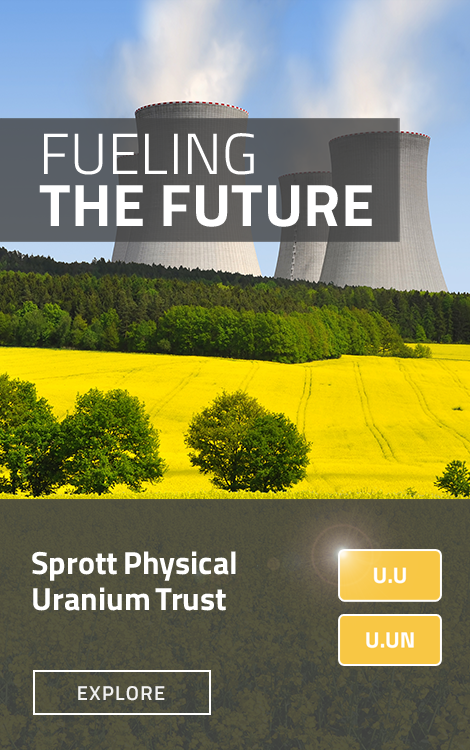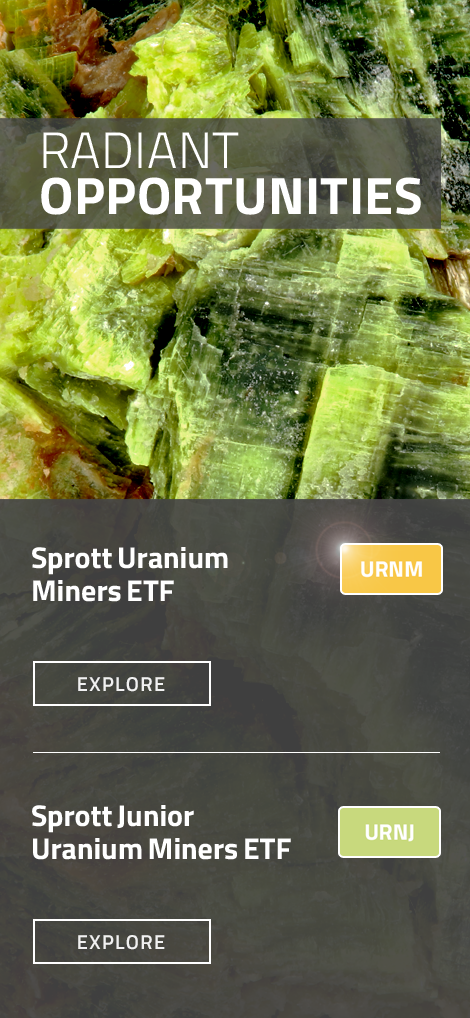September 22, 2025 | (13 mins 47 secs)
Per Jander of WMC joins Jimmy Connor of Bloor Street Capital at the World Nuclear Symposium 2025. Jander reflects on his 20 years at the World Nuclear Symposium, noting the industry’s growing optimism and Microsoft’s entry as a paradigm shift. Jander highlights uranium market dynamics and sees limited downside for the sector, given rising utility contracting and strong fundamentals.
Watch more Bloor Street Capital videos on https://www.youtube.com/@BloorStreetCapital
Video Transcript
James Connor: Per, thank you very much for joining us. You mentioned that you've been attending the World Nuclear Symposium for 20 years.
Per Jander: It is my 20th year this year—hard to believe.
James Connor: I'm curious how things have evolved over the past 20 years.
Per Jander: My hair is grayer. This symposium is the 50th in total. It is a little bit bigger than it was before. It's just the momentum and optimism in this industry. It's really something special this year.
It's a great time to have the anniversary, but it also shows that this industry is feeling some tailwinds. It's exciting to see everybody after a little bit of a break over the summer, to have everybody get together and kick off the fall session. It's probably the most exciting one so far.
James Connor: To your point, one of the reasons why it is exciting is that one of the new members of the World Nuclear Association is Microsoft. The WNA has been promoting this fact, and maybe you can speak to that and their entrance into this industry.
Per Jander: It's usually just the miners and utilities. We are in our own little corner of the world. Our industry is a little club. We like to hang out together and are like a little family. But now you're starting to have companies like that come in, which shows that it is really momentous. It is a paradigm shift for nuclear energy as a whole. It is important to see companies like that come in with their capacity and resources. It's very exciting to see.
The industry itself is growing a little too slowly. Utilities can’t ramp up as quickly as one of these hyperscalers [large cloud/tech companies] would like to see. I welcome them here if they can get involved and kickstart a few things. It's very exciting. I haven't seen them yet, but I've been too busy in meetings. Hopefully, I can catch one or two of them here. That would be great.
James Connor: I want to ask you about the uranium spot market, where you spend much of your time. I'm sure you would agree when I said frustration characterized 2024 because we had a big pullback. This year, it seems to be more stable, and maybe you could say it's consolidating, and it looks like it's grinding higher. Can you speak to what you're seeing in the spot market right now, and what are your thoughts as we go into year-end?
Per Jander: You get a very good feel for what's around when you are in the market. That was a very good learning process for us because we've been fairly quiet for some time to see what the state of the market is. Now we have a much better picture of that. Also, with the recent news, some large producers are having production issues. I think that goes to show that mining is not easy. Having that news come out leading into this big start of the fall session is very constructive. It gets on people's radar screen that you can't take the uranium supply for granted, and people need to pay attention to it.
James Connor: Year to date, approximately 32 million pounds have traded in the spot market. But in terms of liquidity, how hard is it to acquire half a million pounds or a million pounds?
Per Jander: It was perhaps easier than we thought, even in June, but it has been because it was quiet for some time. Some chunkier pockets were lying around. That surprised us first when we found it, but it also surprised the rest of the market. Then you saw a lot of material coming in due to that.
That chunk is cleared out now, and it's a much more balanced market today. There was only one buyer in June—us. Now, there are a few around as well. It's a much more balanced spot market. To buy half a million pounds today, I think you can find it, but the price won't stay where it is.
James Connor: What's your sense about the floor? Do you think the low 70s are the floor for the uranium price?
Per Jander: It depends on the dynamics on any given day. If someone dumps a bunch of stuff in the market, no buyers will be around. But anything with the six in front of it, I think a row of utilities would pick it up.
After spending a couple of days here and just feeling how investors think about the space after the announcement of the production issues, I think anyone would pick them up as well. I find it hard to see that we would have a big pullback at this point anyway. Going forward, exactly where it will go depends on several factors. I would certainly say there's a lot more upside and downside.
James Connor: Let's talk about the term market, and it's been really quiet this year. Approximately 45 million has been contracted here today. What's your sense there? And why has it been so quiet?
Per Jander: It was correct for the first few months of the year, when it was quiet. But then after that, there's been a fair number of RFPs, and I would say reporting is voluntary. You don't have to report if you don't want to. I can certainly understand if you're a utility, and you have a lot of uranium to buy, you don't want to signal it because now they know that that's a number that investors really look at.
If they start signaling, they say, "We're buying a lot of uranium. " They say, "Oh, contracting activity is up, a lot of investors are going to pile in." While this might not affect the term market itself, it will affect the spot price, and the spot price, in turn, will affect your floors and ceilings that you're negotiating.
They're probably being a little bit more coy about it, about how much they are contracting. It doesn't seem like the 40-45 million pounds, whatever that is, really drives the activity we have seen. I would not be surprised if the number is quite a bit higher, but we don't know exactly what that is.
But there is some reporting after the fact that can happen. For example, three U.S. utilities came out for RFPs in July, which is usually a very quiet month. You add up the combined volume of those RFPs versus what was reported in the contract at the end of the month, and the reported number was much higher. That, to me, says that they accepted several offers.
Again, it's a very opaque market and getting even more opaque, which I understand is frustrating for an investor. But if you're a utility and have a significant amount of contracting to do, I don't necessarily blame them. It's just something we're going to have to live with. That number is probably not worth staring yourself blind at.
It just adds even further opaqueness, which is hard. I also think investors here on the ground, talking to active companies and traders, at least the ones I've spoken to so far, come away very constructive.
James Connor: We saw a large RFP from the Koreans, 8.8 million pounds over 10 years, with a floor of $65 and a ceiling of $101. What do you think of those terms?
Per Jander: They're not even escalated. I was at a lunch yesterday, and I was quoting these numbers, and I saw a row of producers sitting in the audience, and I couldn't see any single one of you guys sending in a compliant offer in that process, and I saw a lot of head nodding. We'll see. Never say never, but I really would be surprised.
James Connor: Those terms are totally unrealistic.
Per Jander: If I were a producer with the available pounds to bid into it, I would certainly not send in a compliant offer. What happened two years ago in a similar process, when they came out, when the market was running from the symposium onwards, they had the same situation. They stipulated that these are the terms you have to abide by to be compliant. They got no compliant bids, so they had to close their fee and reissue it with higher levels. The same thing happened again. The market moved away from them. No one sent in a compliant offer. They repeated this process three times and ended up contracting in January instead of September and October. Obviously, it hurt them because the spot market moved from $55 or $60 to over $100. I'm not saying it will be an exact repeat this time, but they're running the risk of having a similar situation.
James Connor: Last year, we saw 106 million pounds contracted in the term market. Do you think we're going to hit 100 million pounds this year?
Per Jander: I think we will. Whether that number will be reported or not remains to be seen. But I feel pretty confident that there is definitely activity going on, and the utilities that I met with are saying that they're preparing to issue them, whether it's going to be Q4 or slide into Q1. But I think we'll see a handful of utilities in the next few months come in with RFPs.
James Connor: You're meeting with many investors and utilities. I'm curious: What are you hearing about these meetings? You spent a lot of time with John Ciampaglia at Sprott, but maybe you can give us some feedback in color on the meetings you're attending.
Per Jander: It was a one-day conference with a bunch of investors, half-hour speed date meetings. But it's similar questions. What are we missing? What's the bear scenario? Will I get the bull scenario, and it's like everyone is asking what can go wrong? You don’t want to sound like too much of a cheerleader, but it’s hard to come up with real risks. It's like everybody, it's a nuclear accident, but they're not very likely. I disregard that case.
You really struggle to come up with something. You can see a major global economic downturn, but it's not just uranium or nuclear energy that gets affected; in that case, we have bigger problems. It's really hard to come up with something. I think people are starting to realize that the downside risk is so low compared to the upside, that this space is starting to get quite exciting for generalist investors, not just the contrarians that were in there early on. I think they have moved on already. Some of them are looking at potentially coming back, but it's more now the big generalist funds. It's quite exciting from that perspective.
At the same time, it is also very exciting on the utility side. One, they've taken care of their enrichment and their conversion needs. Now, they're starting to put their attention on uranium itself, but they also have very exciting new build plans. These are plans that aren't necessarily investment decisions that have been made yet. But they certainly plan for it. This is something, a 10-year project or whatever it might be.
But every single one, they're starting to have plans. They have their work cut out for them, but at least it's a very exciting challenge to have like that. We get to do something new. We don't have to worry about how to cut this thing down, transport it or decommission it. We're worrying about how to build it new, restart it or how to extend its lifetime. It just gives an overall feel. The industry is in a very healthy place right now.
James Connor: Per, as we wrap up, you've spoken with many people at the conference in the last couple of days. Do you have any other insights you want to share?
Per Jander: No, it's just that it feels constructive, positive, and doesn't feel hyped up. It just feels like the rubber hitting the road. The fires that were put out when it comes to other concerns about the fuel cycle. Now it's really time to worry about uranium, not just near-term uranium, but what's happening five and 10 years from now. That fundamental momentum is building up, which is healthy, and it's about time.
James Connor: I'm glad you brought that point up because I spoke to somebody here, and they said they sat in many meetings. One of the points they made was that everybody's talking about nuclear reactors and nuclear energy. No one's talking about uranium.
Per Jander: They think they need to worry about where the new mines are.
James Connor: Thank you very much for spending time with us. I know you had a full day of meetings, so I don't want to keep you any longer. Once again, thank you.
Per Jander: Thanks a lot, Jimmy.
Investment Risks and Important Disclosure
Spot Market is where uranium is bought and sold for immediate delivery. Prices can change quickly based on supply and demand. It's like buying something off the shelf today. Term Market involves long-term contracts, often spanning several years. Buyers, like utilities, lock in prices and delivery schedules in advance to ensure future supply. Spot is short-term and reactive; term is long-term and planned.
Relative to other sectors, precious metals and natural resources investments have higher headline risk and are more sensitive to changes in economic data, political or regulatory events, and underlying commodity price fluctuations. Risks related to extraction, storage and liquidity should also be considered.
Past performance is no guarantee of future results. You cannot invest directly in an index. Investments, commentary and opinions are unique and may not be reflective of any other Sprott entity or affiliate. Forward-looking language should not be construed as predictive. While third-party sources are believed to be reliable, Sprott makes no guarantee as to their accuracy or timeliness. This information does not constitute an offer or solicitation and may not be relied upon or considered to be the rendering of tax, legal, accounting or professional advice.



